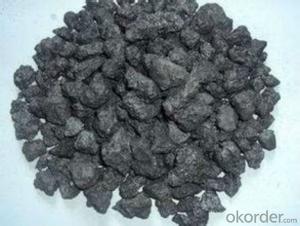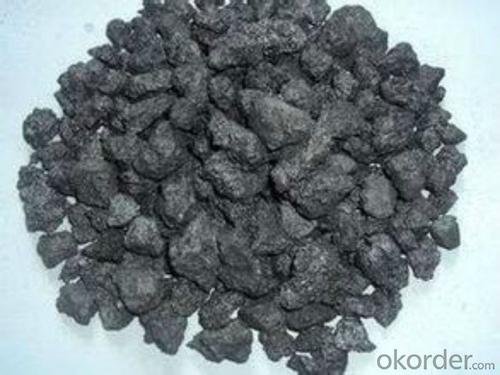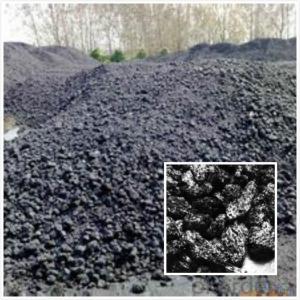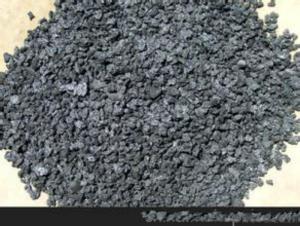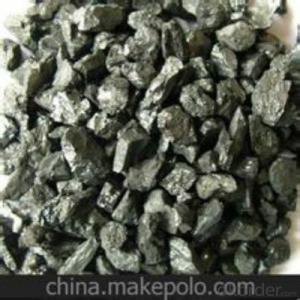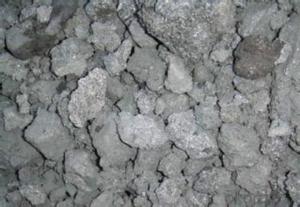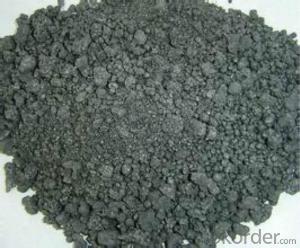Calcined Petroleum Coke as Carbon Additive with S0.7%max
- Loading Port:
- Tianjin
- Payment Terms:
- TT OR LC
- Min Order Qty:
- 19.2
- Supply Capability:
- 1002 m.t./month
OKorder Service Pledge
OKorder Financial Service
You Might Also Like
Intrduction
Carbon additive to ningxia production of anthracite as raw material, after washing, crushing, high temperature calcination, filter, etc. Craft refined and become.This is after the anthracite calcination generated high carbon content and low volatile component of the new product, is an ideal raw material to make steel.Steady Quality
Calcined Petroleum Coke comes from delayed coke which extracted from oil refinery. Although Calcined Petroleum Coke contains a little bit higher level of sulfur and nitrogen than pitch coke, the price advantage still makes it widely used during steel-making and founding as a kind of carbon additive/carburant.
Features
In the smelting process for reducing agent. Performance: replace the traditional oil carbon additive, decrease the cost of steelmaking. Features: low ash. low sulfur,low phosphorus, high calorific value. High ratio resistance,high mechanical strength,high chemistry activity. It is mainly used for metallurgy reductant inoculants, casting, refractory materials, machinery, electronics and other fields.
1) high absorption rate, it can be absorbed up to 90%.
2) absorbed more quickly than other carbon additive; no residue remains in furnace.
3) low Sulfur, the lowest can reach below 0.20%; low nitrogen, normally below 200ppm (0.02%)
Specifications
CPC | |||
F.C.% | 98.5MIN | 98.5MIN | 98MIN |
ASH % | 0.8MAX | 0.8MAX | 1MAX |
V.M.% | 0.7 MAX | 0.7 MAX | 1 MAX |
SULFUR % | 0. 5MAX | 0. 7MAX | 1MAX |
MOISTURE % | 0.5MAX | 0.5MAX | 1MAX |
Pictures
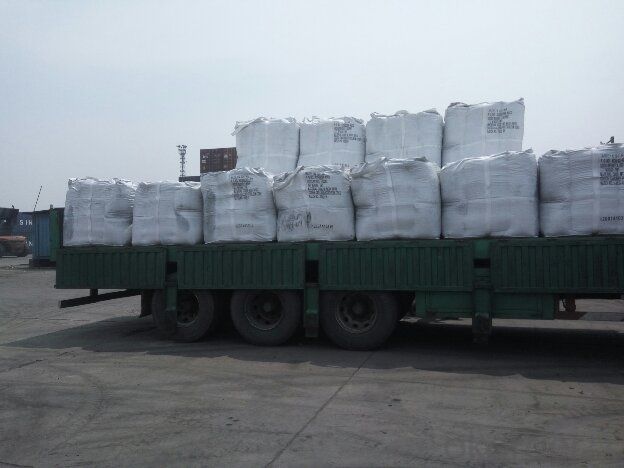
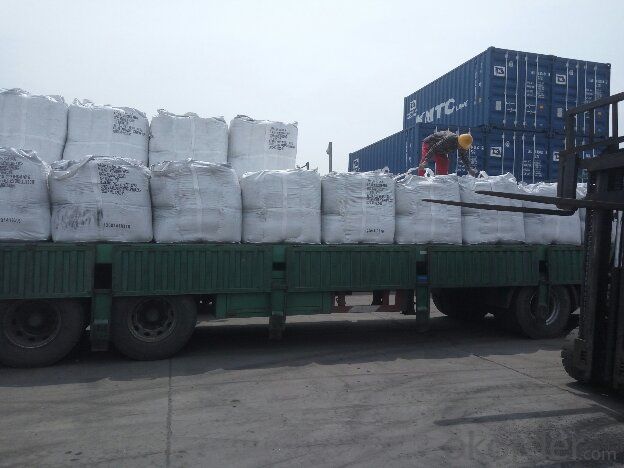
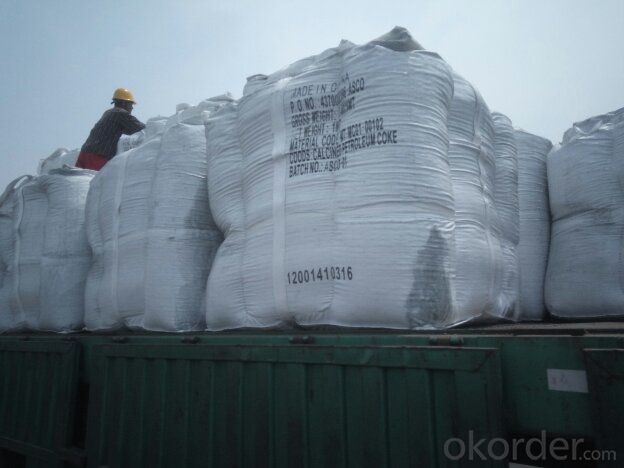
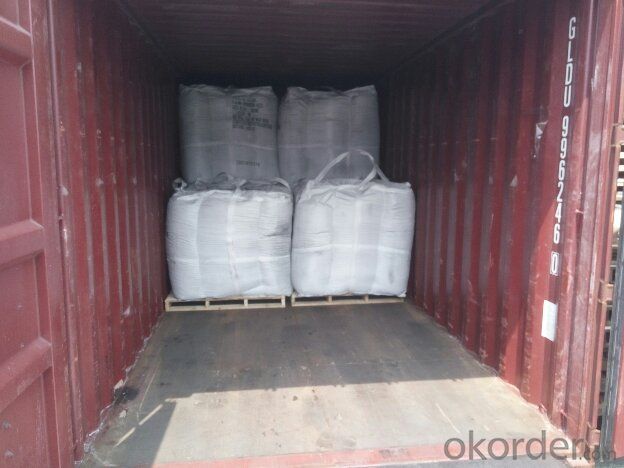
FAQ:
(1)CPC could be as fuel
Petroleum coke is a material relatively low in cost and high in heat value and carbon content with good chemical stability, making it an efficient and costeffective fuel for producing metal, brick and related products.
(2)CPC could be as Graphite Electrodes
Graphite can be produced from lowsulfur needle petroleum coke, which must be heated above 5,432 degrees Fahrenheit.
(3)CPC could be as Anodes
Calcined petroleum coke, often low in sulfur and metallic impurities, is used to make anodes for
the smelting industry.Calcined petroleum coke is mixed with coal tar pitch in the production of
anodes.
- Q: What is carbon emission and what harm does it do? How can carbon dioxide be prevented?
- Carbon deposition reaction:CH4 = kJ/mol C+H274.92CO = CO2+C +172.4 kJ/mol on.The main cause of carbon analysis is that the ratio of water to carbon is too low, so that the rate of carbon removal is lower than the rate of carbon depositionThe above chemical reactions are reversible reaction, from the analysis of thermodynamics, if the increase in temperature or reducing system pressure, increase the possibility of methane decomposition reaction type is CH4 C+H2 produce coke; possibility of CO reaction 2CO = CO2+C and CO = C + H2 reaction +H2O produce coke decrease. If the temperature is reduced or increased the pressure is on the contrary. The effect of temperature on coke reaction is very large, to avoid the [wiki] [/wiki] carbon catalyst must select the appropriate temperature, avoid carbon deposition area.
- Q: What is the carbon content of different types of soil?
- The carbon content of different types of soil can vary significantly depending on various factors such as climate, vegetation, and land management practices. Generally, soils with higher organic matter content tend to have higher carbon content. Peat soils, for example, have the highest carbon content among all soil types, ranging from 30% to 60%. These soils are formed in wetland areas where the decomposition of organic matter is slow due to water saturation. As a result, large amounts of carbon accumulate over time. Forest soils also tend to have relatively high carbon content, varying between 1% and 10%. Forests provide a continuous supply of organic matter through litterfall, which contributes to the build-up of carbon in the soil. Agricultural soils, on the other hand, typically have lower carbon content compared to peat or forest soils. The carbon content of agricultural soils is influenced by factors such as crop rotation, organic amendments, and tillage practices. Depending on these factors, carbon content in agricultural soils can range from less than 1% to around 6%. Grassland soils may have carbon contents similar to agricultural soils, depending on the management practices. However, in undisturbed grasslands with high plant productivity, carbon content can be relatively higher, ranging from 2% to 8%. In arid and desert regions, soils tend to have lower carbon content due to limited vegetation and slower organic matter decomposition rates. Carbon content in these soils is often less than 1%. It is important to note that these ranges are generalizations, and the carbon content of soil can vary within and between soil types. Additionally, changes in land use, such as deforestation or conversion of grasslands to agriculture, can significantly impact the carbon content of soils.
- Q: What are carbon sinks?
- Carbon sinks, whether natural or artificial, have the important role of absorbing and storing carbon dioxide from the atmosphere, thereby lessening the concentration of greenhouse gases and mitigating climate change. These carbon sinks exist in various forms, such as forests, oceans, wetlands, and soil. Among these, forests are the largest and most widely recognized carbon sinks. Through photosynthesis, trees take in carbon dioxide and convert it to oxygen, storing the carbon within their trunks, branches, and roots. Oceans also serve as significant carbon sinks, absorbing about a quarter of the carbon dioxide emitted by human activities. Algae, phytoplankton, and other marine organisms carry out photosynthesis and convert carbon into biomass. Wetlands, including marshes and swamps, are another crucial carbon sink. They store vast amounts of carbon within their vegetation and soil, preventing its release into the atmosphere. Additionally, soil acts as a carbon sink by absorbing and storing carbon through the decomposition of organic matter and the activities of microorganisms. To further combat climate change, artificial carbon sinks like carbon capture and storage (CCS) technologies are being developed. CCS involves capturing carbon dioxide emissions from power plants and industrial facilities and either storing them underground or repurposing them for other uses. Although these technologies are still in their early stages, they hold the potential to significantly reduce carbon emissions and contribute to climate stabilization. Overall, carbon sinks are vital for maintaining a balanced level of carbon dioxide in the atmosphere and preventing its accumulation, which would contribute to global warming. It is crucial to preserve and restore natural carbon sinks, such as forests and wetlands, in order to mitigate climate change. Additionally, the development and implementation of artificial carbon sinks can further aid in reducing greenhouse gas emissions.
- Q: How does carbon affect the formation of haze?
- Carbon plays a significant role in the formation of haze due to its ability to interact with other pollutants and atmospheric conditions. When carbon-containing compounds, such as fossil fuel emissions or organic matter from wildfires, are released into the atmosphere, they undergo chemical reactions with gases like nitrogen oxides and volatile organic compounds. These reactions result in the formation of secondary organic aerosols (SOAs), which are tiny particles suspended in the air. These SOAs can contribute to haze formation by scattering and absorbing sunlight, reducing visibility and creating a hazy appearance. The carbon particles can also serve as condensation nuclei, attracting other pollutants and water vapor, leading to the formation of larger particles and subsequently haze. Additionally, the interaction between carbon and atmospheric moisture can result in the formation of secondary organic aerosol particles that contribute to haze formation. Furthermore, carbon particles can contribute to the formation of photochemical smog, which is a type of haze characterized by high levels of ozone. Carbon-containing pollutants can react with sunlight and other pollutants, leading to the production of ozone. This ozone, along with other pollutants, can contribute to the formation of haze and reduce air quality. In summary, carbon affects the formation of haze by contributing to the formation of secondary organic aerosols, serving as condensation nuclei, and promoting the production of ozone. Understanding the role of carbon in haze formation is crucial for implementing effective air pollution control measures and mitigating the impacts of haze on human health and the environment.
- Q: How much is a ton of carbon fiber? How much difference is made between domestic and imported?
- To 12K carbon fiber, for example, domestic prices between 16~17 million, imports of Dongli carbon fiber prices between 27~29 million.
- Q: What are the consequences of increased carbon emissions on indigenous communities?
- Increased carbon emissions have significant consequences on indigenous communities. Firstly, these communities often rely on the land and natural resources for their livelihoods, so environmental degradation caused by carbon emissions can directly impact their ability to hunt, fish, and gather food. Additionally, climate change resulting from carbon emissions leads to more frequent and intense natural disasters, such as hurricanes and droughts, which can destroy homes and infrastructure in indigenous communities. Moreover, the loss of traditional knowledge and cultural practices associated with the changing environment can have profound social and psychological impacts on indigenous peoples. Overall, increased carbon emissions exacerbate existing inequalities and vulnerabilities faced by indigenous communities, threatening their way of life, well-being, and resilience.
- Q: How does carbon contribute to the strength of alloys?
- Carbon contributes to the strength of alloys by forming interstitial solid solutions with metals, which increases the hardness and strength of the material. The carbon atoms occupy the spaces between the metal atoms, creating lattice distortions and enhancing the overall strength of the alloy. Additionally, carbon can also form compounds with metals, such as carbides, which further improve the hardness and wear resistance of alloys.
- Q: DNF new advanced furnace rock carbon reinforcement +10 50 powder weapons, the upper 11 probability of success is how much, how many advanced furnace rock carbon?
- Seemingly increased only 3.39 small, if we can make the cost of reaching the 80% chance of strengthening, so strengthen the probability of using advanced carbon can reach 88%. Why do you say that? First of all, let's make sure that the random ones in the game are fake. No matter what, random in the game is not real, but computer controlled pseudo random. There are two pseudo random, I simply explain. One is to simulate the real random situation, such as the weather forecast by computer simulation, in this case the random also is not true, because we had already entered the specific results, no matter how the computer is random, will have sun or rain and thunder like, the computer can not simulate the RMB under the sky the weather, because the program did not give it such a result, so although it seems very real, is actually false, is pseudo random. The other is random, which contains certain specific rules, which are widely used in competitive games, which is what we usually call the reinforcement probability. The reinforcement rate is 28%, with fixed values, but it is also controlled by the program and is pseudorandom. The reinforcement of odds is not what we imagine, but the effect of seeing Kylie's sister's feelings, whether successful or not, affects the chances of the next reinforcement. In this case, each reinforcement is not an independent event because it is affected by what happened before, and for each of the truly random or previous pseudo random events, each should be an independent event. Take random hits in the game as an example.
- Q: What is carbon nanocomposite?
- Carbon nanocomposite refers to a material that is made up of carbon nanoparticles embedded in a matrix material. This combination results in a material that exhibits enhanced mechanical, thermal, and electrical properties, making it suitable for a wide range of applications such as aerospace, electronics, and energy storage.
- Q: How is carbon formed in stars?
- Carbon is formed in stars through a process called stellar nucleosynthesis, specifically in the later stages of a star's life. This occurs when helium nuclei (alpha particles) fuse together under high temperatures and pressures to form carbon nuclei.
Send your message to us
Calcined Petroleum Coke as Carbon Additive with S0.7%max
- Loading Port:
- Tianjin
- Payment Terms:
- TT OR LC
- Min Order Qty:
- 19.2
- Supply Capability:
- 1002 m.t./month
OKorder Service Pledge
OKorder Financial Service
Similar products
Hot products
Hot Searches
